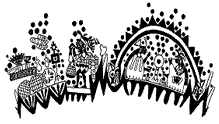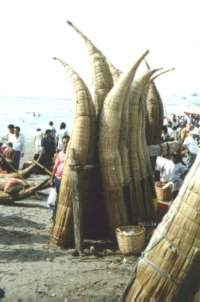|
 The
Pacific coast of Peru, one of the earth's most arid regions, was
once home of sophisticated civilisations. The North coast of this
Southamerican country features spectacular contrasts between fertile
valleys and stark deserts, all wedged in a thin
coastal strip between the richness of the Pacific
Ocean and the high mountains of the tropics.
This region enjoys a rich archaeological legacy of various Pre-Inca
civilisations. The
Pacific coast of Peru, one of the earth's most arid regions, was
once home of sophisticated civilisations. The North coast of this
Southamerican country features spectacular contrasts between fertile
valleys and stark deserts, all wedged in a thin
coastal strip between the richness of the Pacific
Ocean and the high mountains of the tropics.
This region enjoys a rich archaeological legacy of various Pre-Inca
civilisations.
 Among
the most important of those civilisations is the Mochicans who peopled
this area between the 1st and the 6th centuries AD. The ruins of
the Moche culture grace the outskirts of cities on the north coast
of Peru, such as Trujillo or Chiclayo. Among
the most important of those civilisations is the Mochicans who peopled
this area between the 1st and the 6th centuries AD. The ruins of
the Moche culture grace the outskirts of cities on the north coast
of Peru, such as Trujillo or Chiclayo.
The Moche civilisation settled in the fertile
valleys along the river Moche surrounded by barren desert lands.
Impressive and sophisticated hydraulic works
were among their best architectural designs. They also built pyramids,
temples and huge entrance ramps with building techniques that can
compare to present-day sophisticated designs. When arranging clay
bricks for a construction they lined them up slightly apart one
from the other so as to allow for heat dilatation and offer resistance
to earthquakes. See figure 1.
In addition to this fabulous archaeological
treasures, the Mochican culture is known to us for its well-preserved
beautiful handicrafts. They made rich human-shaped pottery of dazzling
beauty. The pottery showed proud and impassive human faces. Most
of these faces represented noblemen and warriors. Among the figures
represented in the pottery we also see the figure of shamans who
still today use natural cures and invoke the ghosts of the ancestors
to treat illness and ward off evil spirits.
 Other
figures represented in the Mochican pottery are animals and ancestral
deities. Other
figures represented in the Mochican pottery are animals and ancestral
deities.
Craftmen worked with clay and used moulds to create pieces in a
serial form. These were fired in ovens and then hand painted and
glazed with vivid colours that have remained till today.
Where these artistic representations a mere expression of the artist
or did they stand for a particular cosmogony?
The answer lies with the latter, the truth being that this abundant
and well-preserved pottery can be considered anthropomorphic. It
expresses mythological and social themes and it might be considered
as the peak of this art genre in the whole civilisation of Peru.
 Among
a range of pottery designs we may highlight figures such as the
one on the right which depicts deities among stars. The Mochicans
believed in the solar heavenly god. Among
a range of pottery designs we may highlight figures such as the
one on the right which depicts deities among stars. The Mochicans
believed in the solar heavenly god.
 In
figures such as the one on the left we see the deity associated
with vegetation. These motifs are those of fertility and are obviously
associated with the cultivation of the land. We must remember that
in the midst of the barrenness of the surrounding lands, the Mochicans
lived in a few fertile oases and that they managed to make a living
from cultivating them. In
figures such as the one on the left we see the deity associated
with vegetation. These motifs are those of fertility and are obviously
associated with the cultivation of the land. We must remember that
in the midst of the barrenness of the surrounding lands, the Mochicans
lived in a few fertile oases and that they managed to make a living
from cultivating them.
Because of all this pottery rich in vegetation
designs , we may conclude that the Mochicans must have been deep
in agrarian mythology.
 It
is also worth underlining that art was a way of passing the culture
of their ancestors down to the new Mochican generations. It
is also worth underlining that art was a way of passing the culture
of their ancestors down to the new Mochican generations.
Death, for instance, didn't just mean the end of life on earth but
the passing away to another world where not only earth privileges
and social class but also obligations continued. Thus, in funeral
ceremonies, whole families and servants were sacrificed and a rich
trousseau was buried with them so as to be used in their new life.
Today, one of the beauties of this area of
Northern Peru, as well as admiring these Mochican artistic remains,
is to enjoy the sight of immaculate sandy beaches where fishermen
still surf in "totora" reed boats of Pre-Columbian design.
In some totoras fishermen fish on their own.
In others, they work with another fisherman. They use nets and harpoons
and it is a delight to the eyes to see them display their catch
on the totora boats as if they were improvised stalls of a market
with prehistoric flavour.
|





 Among
the most important of those civilisations is the Mochicans who peopled
this area between the 1st and the 6th centuries AD. The ruins of
the Moche culture grace the outskirts of cities on the north coast
of Peru, such as Trujillo or Chiclayo.
Among
the most important of those civilisations is the Mochicans who peopled
this area between the 1st and the 6th centuries AD. The ruins of
the Moche culture grace the outskirts of cities on the north coast
of Peru, such as Trujillo or Chiclayo.

 Among
a range of pottery designs we may highlight figures such as the
one on the right which depicts deities among stars. The Mochicans
believed in the solar heavenly god.
Among
a range of pottery designs we may highlight figures such as the
one on the right which depicts deities among stars. The Mochicans
believed in the solar heavenly god. 
 It
is also worth underlining that art was a way of passing the culture
of their ancestors down to the new Mochican generations.
It
is also worth underlining that art was a way of passing the culture
of their ancestors down to the new Mochican generations.